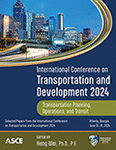Assessing the Impacts of Real-Time GPS Navigation Applications on Trip Routing and Diversion Rates
Publication: International Conference on Transportation and Development 2024
ABSTRACT
Smartphone navigation applications and in-vehicle navigation technologies provide drivers with real-time traffic conditions and route guidance among other numerous benefits. These technologies promise transformative improvement in daily commutes and prevent the possible increase in traffic delays and congestion. The limits of such benefits are dependent on the frequency of using the navigation applications, diversion rates, and the percentage compliance with the suggested re-routing. Commuters in Broward County, southeastern Florida, were surveyed to understand their preferences and the factors affecting route choice decisions. A multiple linear regression model was used to predict actual traffic diversion rates and to validate the survey results. Major findings of this research included a variety of characteristics associated with navigation applications, drivers’ behavior, and roadway facility usage. In general, navigation applications have a significant re-routing potential, and drivers are likely to divert 20% to 39% of the time. It was found that most drivers would consider a re-routing suggestion when the delay per 1-h trip is approximately 15−30 min. Finally, the results were consistent with the regression model and showed that the actual diversion rate ranged from 1% to 20%.
Get full access to this chapter
View all available purchase options and get full access to this chapter.
REFERENCES
Adler, J. L., Golob, T. F., and McNally, M. G. (1993). A structural model with discrete-choice variables for predicting enroute behavior under ATIS.
Arafat, M., Hadi, M., Hunsanon, T., and Amine, K. (2021). Stop sign gap assist application in a connected vehicle simulation environment. Transportation research record, 2675(9), 1127–1135.
Arafat, M., Hadi, M., Raihan, M. A., Iqbal, M. S., and Tariq, M. T. (2021). Benefits of connected vehicle signalized left-turn assist: Simulation-based study. Transportation Engineering, 4, 100065.
Arafat, M., Nafis, S. R., Sadeghvaziri, E., and Tousif, F. (2020). A data-driven approach to calibrate microsimulation models based on the degree of saturation at signalized intersections. Transportation Research Interdisciplinary Perspectives, 8, 100231.
Burgess, L., Toppen, A., and Harris, M. (2012). Vision and Operational Concept for Enabling Advanced Traveler Information Services: Operational Concept. United States. Joint Program Office for Intelligent Transportation Systems.
Cohn, N. (2009). Real-time traffic information and navigation: An operational system. Transportation research record, 2129(1), 129–135.
Guin, A., Hadi, M., Wang, F., Watkins, K., Hunter, M. P., Iqbal, M. S., … and Arafat, M. (2021). Impact of Smartphone Applications on Trip Routing (No. Project A). Southeastern Transportation Research, Innovation, Development and Education Center (STRIDE).
Hadi, M., Iqbal, M. S., Wang, T., Xiao, Y., Arafat, M., and Afreen, S. (2019). Connected vehicle vehicle-to-infrastructure support of active traffic management. Florida Department of Transportation. Office of Research and Development, Tallahassee, FL, 2019.
Hadi, M., Xiao, Y., Iqbal, M. S., Wang, T., Arafat, M., and Hoque, F. (2019). Estimation of system performance and technology impacts to support future year planning. Florida Department of Transportation. Office of Research and Development, Tallahassee, FL, 2019.
Jou, R. C., and Mahmassani, H. S. (1996). Comparability and transferability of commuter behavior characteristics between cities: departure time and route-switching decisions. TRR1556(1),119–130.
Khattak, A., Polydoropoulou, A., and Ben-Akiva, M. (1996). Commuters’ normal and shift decisions in unexpected congestion: Pre-trip response to advanced traveler information systems.
Mahmassani, H. S., Caplice, C. G., and Walton, C. M. (1990). Characteristics of urban commuter behavior: switching propensity and use of information. Transportation Research Record, (1285).
Pal, R. (1998). Investigation on latent factors affecting route diversion intentions. Journal of transportation engineering, 124(4), 362–367.
Sharafeldin, M., Farid, A., and Ksaibati, K. (2022). Examining the risk factors of rear-end crashes at signalized intersections. Journal of Transportation Technologies, 12(4), 635–650.
Sharafeldin, M., Farid, A., and Ksaibati, K. (2022). A random parameters approach to investigate injury severity of two-vehicle crashes at intersections. Sustainability, 14(21), 13821.
Shirazi, et al. (1988). Commuters’ Attitudes Toward Traffic Information Systems and Route Diversion.
Tariq, M. T., Saha, R., and Hadi, M. (2022). Data and modeling support of the management of diversion routes during freeway incidents. Transportation research record, 2676(6), 437–452.
Wade, A. R., Ziedman, D., Rosenthal, T., Stein, A., Torres, J., and Halati, A. (1991). Laboratory assessment of driver route diversion in response to in-vehicle navigation and motorist information systems. Transportation Research Record, 1306, 82–91.
Information & Authors
Information
Published In
History
Published online: Jun 13, 2024
Authors
Metrics & Citations
Metrics
Citations
Download citation
If you have the appropriate software installed, you can download article citation data to the citation manager of your choice. Simply select your manager software from the list below and click Download.
